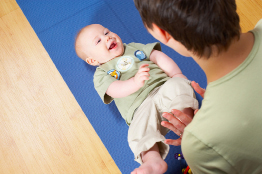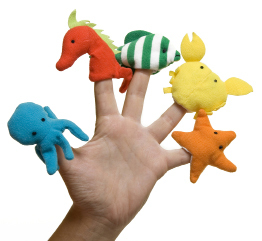Session 3
1. Session 3
1.1. Inquiry 1
Session 3: Language Development
Inquiry 1: Promoting Language Development
To provide you with an overview of the language development of children between the ages of birth to six years, watch the video “Language Development”
Connecting with Each Child

Brand X Pictures/Thinkstock
Children develop their language skills by doing the following:
- interacting with other children
- interacting with adults
- imitating sounds, words, and sentences
Children’s self-esteem plays an important role in the development of interaction and language skills.
Follow these strategies to connect with each child:
- Give respect and affection—doing so will help children feel more confident and be more willing to imitate what they see and hear.
- Take a moment to notice each child as an individual. All babies and children communicate. Pay attention to their facial expressions, body movements, what they are looking at, what they are reaching for, what they are playing with, and so on.
- Respond quickly. Be attentive and respond quickly to each child’s attempt to communicate with you.
- Observe and listen to each child. Watch, listen, and learn what each child finds interesting. Listen to the sounds and words the child uses.
- “Tune in” to each child. The way in which children interact with other children is important. For example, does a child only speak to one play partner at a time? Is the child able to take turns in talking with a playmate? If a child is unable to play, show the child how to play by being the child’s play partner. Gradually withdraw from the play when you see that the child is able to play with another partner.
- Have face-to-face contact. Children learn language best when they can see your face. Sometimes children need to watch your mouth to see the physical movements you make to produce a sound.
- Use appropriate physical contact. Close proximity and physical contact help the child focus attention on you and reinforce your relationship. Touching the child gently on the shoulder helps to maintain eye contact and makes the child feel secure.
- Use the child’s name before speaking. This helps to get the child’s attention.
- Imitate the child. This is perhaps the most important way to connect. It shows the child that you are listening and that you think what the child is saying or doing is important. In addition to repeating the child’s words, you can also add words. For example, if a toddler says, “ball,” you can say, “Yes. Ball. A big, big ball.”
- Play with each child. Children will more likely use their speech and language when they are having fun.
Adapted from content provided by Grant MacEwan University and Alberta Health Services.
Children’s Needs for Language Development
- Children need many opportunities to interact with adults during the day.
- Children need lots of opportunities to play with toys, children, and adults, in order to practise language skills.
- Children need time to play in groups, but also time for individual attention from an adult who can engage in conversation with the child.
- Children need toys, books, and props that promote conversations and experimentation with language (e.g., puppets, books, and dolls).
- Children need to have the opportunity to learn songs, finger plays, and poems that encourage language development.
- Children need time to think about what words they will use (wait five to ten seconds after asking a child a question).
- Children need adults to model appropriate social language.
vocabulary: the words a child understands and uses
Creating Environments for Language Play

Photos.com/Thinkstock
As expressed in the video, children learn language as they play. As infants, children experiment with sound as they shake toys and objects. Infants imitate actions, sounds, and gestures.
Toddlers add new words and names for the objects and people in their environment. Preschoolers experience a massive explosion of vocabulary and grammar. They begin to blend their active play with more symbolic expressions as they develop the “scripts” of their “play scenarios.” For example, children say, “Let’s pretend,” or “You be the mom and I’m the dad.”
The Role of the Caregiver
Follow these strategies to create an environment for language development:
- Be each child’s play partner—doing so lets the child know that what the child has to say is important, which encourages the child to speak more. Being a play partner provides opportunity for you to make observations and to determine where the child needs help.
- Encourage children to follow their own interests in play. Children learn language best when you talk about what they are focusing on. Use repetition.
- Observe each child and plan play that reflects what the child likes to do.
- Use words and sounds to match the interests and activities of a child. Toddlers like to experiment with simple sounds like “oooh,” “mmmmm,” or “crunch.” Notice the sounds around you and say the words (e.g., “listen to the wheels go s-q-u-e-a-k”) or make action noises (e.g., say “whoosh” when swinging).
- Encourage children to make choices—doing so encourages their senses of independence and self-confidence.
- Ask open-ended questions. Questions that don’t have a simple “yes” or “no” answer give children the opportunity to practise and play with language. The question, “What are you wearing today?” lets the child use lots of language to respond. “Are you wearing a new sweater today?” allows only a one-word answer: yes or no.
- Children need time to think about the words they will use. A good rule to follow is to wait five to ten seconds after asking a child a question. The child may need this much time to answer. Accept what the child says, and then add a response to have a two-way conversation.
- Provide age-appropriate play materials that give endless opportunities for creativity—“open-ended” materials, such as sand, water, blocks, books, and art materials, provide flexible opportunities for children to follow their interests and to move at their own paces. Introduce different words, concepts, and grammatical structures as the children explore and create.
- Provide props that encourage language play and literacy. Puppets and books can encourage language play and support literacy development. Picture books should be a part of the play centres throughout the playroom.
- Use songs, finger plays, and poems to support play at various centres. Add new songs by making up sentences that describe what the child is doing and by signing those words to a favourite tune. These kinds of songs make the children’s play more exciting and stretch the child’s language development. Use picture books to match singing with printed words. Read stories with lots of expression in your voice.
- Incorporate the languages spoken by all the children. Learning a few words in a new language can be done by asking the child’s parent, by using an Internet language program, or by asking a language teacher in your school. Include words both orally and visually. Incorporating a child’s first language supports the child’s learning and encourages a sense of belonging.

iStockphoto/Thinkstock
Review the Language Development video clips to see some of the strategies discussed above being used by child care providers. As you watch the videos this time, ask yourself the following questions:
- Do I understand the information better or differently than when I first watched the video?
- Have I observed any of the strategies presented being used with the children in the child care facility?
- How could I use the information presented to develop items and strategies that support language-rich environments for my strategies box?
Supporting Language Development
To support language development, be sure routines and boundaries are in place. For example, young children need at least 30-minute play sessions as this allows time for the language that goes with the play to develop and become more complex.
Adapted from content provided by Grant MacEwan University and Alberta Health Services.
A variety of play centres in which children can interact with various toys, concepts, ideas, and so on, is also important for children’s language development. Information on establishing routines and guidelines as well as on organizing the physical space within a child-centred facility was included in Session 4: Guiding Children’s Behaviour in CCS3110. Review your work from this session in your CCS3110 course folder. Consider carefully the information on the physical environment, routines, transitions and activities. In addition, review the child care provider’s interaction styles and methods for intervention and for setting clear guidelines. As you review all of this information, consider how your practices could either encourage and support or delay or prevent children’s language development.
Course Completion Checklist
Have you remembered to update your Course Completion Checklist? If you haven’t already started to use the checklist, access it in the Toolkit now. Remember to update the checklist every time you work on the course.